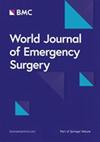Emergency robotic surgery: the experience of a single center and review of the literature
IF 5.8
1区 医学
Q1 EMERGENCY MEDICINE
引用次数: 0
Abstract
Laparoscopic surgery is widely used in abdominal emergency surgery (AES), and the possibility of extending this approach to the more recent robotic surgery (RS) arouses great interest. The slow diffusion of robotic technology mainly due to high costs and the longer RS operative time when compared to laparoscopy may represent disincentives, especially in AES. This study aims to report our experience in the use of RS in AES assessing its safety and feasibility, with particular focus on intra- and post-operative complications, conversion rate, and surgical learning curve. Our data were also compared to other experiences though an extensive literature review. We retrospectively analysed a single surgeon series of the last 10 years. From January 2014 to December 2023, 36 patients underwent urgent or emergency RS. The robotic devices used were Da Vinci Si (15 cases) and Xi (21 cases). 36 (4.3%) out of 834 robotic procedures were included in our analysis: 20 (56.56%) females. The mean age was 63 years and 30% of patients were ≥ 70 years. 2 (5.55%) procedures were performed at night. No conversions to open were reported in this series. According to the Clavien-Dindo classification, 2 (5.5%) major complications were collected. Intraoperative and 30-day mortality were 0%. Our study demonstrates that RS may be a useful and reliable approach also to AES and intraoperative laparoscopic complications when performed in selected hemodynamically stable patients in very well-trained robotic centers. The technology may increase the minimally invasive use and conversion rate in emergent settings in a completely robotic or hybrid approach.急诊机器人手术:单个中心的经验和文献综述
腹腔镜手术被广泛应用于腹部急诊手术(AES),而将这种方法推广到最新的机器人手术(RS)的可能性引起了人们的极大兴趣。机器人技术推广缓慢的主要原因是成本高,而且与腹腔镜手术相比,RS手术时间更长,这可能是阻碍其推广的因素,尤其是在腹部急诊手术中。本研究旨在报告我们在 AES 中使用 RS 的经验,评估其安全性和可行性,尤其关注术中和术后并发症、转换率和手术学习曲线。我们还通过广泛的文献回顾,将我们的数据与其他经验进行了比较。我们回顾性分析了过去 10 年中的单个外科医生系列。从2014年1月到2023年12月,36名患者接受了紧急或急诊RS手术。使用的机器人设备是达芬奇 Si(15 例)和 Xi(21 例)。在834例机器人手术中,有36例(4.3%)纳入了我们的分析:其中20例(56.56%)为女性。平均年龄为 63 岁,30% 的患者年龄超过 70 岁。2例(5.55%)手术在夜间进行。该系列手术中没有转为开放手术的报告。根据克拉维恩-丁多(Clavien-Dindo)分类法,共收集到2例(5.5%)主要并发症。术中死亡率和 30 天死亡率均为 0%。我们的研究表明,如果在训练有素的机器人中心对选定的血流动力学稳定的患者进行手术,RS也可能是治疗AES和术中腹腔镜并发症的一种有用而可靠的方法。该技术可能会增加微创手术的使用率,并提高完全机器人或混合方法在紧急情况下的转换率。
本文章由计算机程序翻译,如有差异,请以英文原文为准。
求助全文
约1分钟内获得全文
求助全文
来源期刊

World Journal of Emergency Surgery
EMERGENCY MEDICINE-SURGERY
CiteScore
14.50
自引率
5.00%
发文量
60
审稿时长
10 weeks
期刊介绍:
The World Journal of Emergency Surgery is an open access, peer-reviewed journal covering all facets of clinical and basic research in traumatic and non-traumatic emergency surgery and related fields. Topics include emergency surgery, acute care surgery, trauma surgery, intensive care, trauma management, and resuscitation, among others.
 求助内容:
求助内容: 应助结果提醒方式:
应助结果提醒方式:


